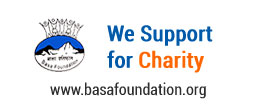
Nepal Tarai Tour
Itinerary Detail
Day 01: Arrival in Kathmandu.
Meet & Welcome by our office representative, transfer to the Hotel. Overnight at Hotel.
Day 02: Kathmandu - Koshi Tappu Wildlife Reserve | 8 Hours drive
After breakfast Drive to Koshi Tappu wildlife Reserve
The reserve is a wetland of international significance. In 1987, it was declared a Ramsar site. It is home to more than 280 bird species including 20 duck species, 2 species of ibises, many storks, egrets and herons. The endangered swamp partridge and Bengal florican are found here. The Koshi Barge is an extremely important resting-place for migratory birds. The last surviving population of wild buffalo or arna is found here. The reserve is also home to many types of mammals such as hog deer, spotted deer, wild boar and blue bull. The endangered Gharial crocodile and Gangetic dolphin have been recorded in the Koshi River. The vegetation mainly includes tall khar-pater grasslands with a few patches of khair-sissoo scrub forest and deciduous mixed riverine forest. During the monsoon, the reserve is flooded with depths ranging from 10 to 300 cm. From season to season the Sapta-Koshi River changes its course. Area of Koshi Tappu Wildlife Reserve 175 sq. km. and established: 1976. Location of Koshi Tappu Wildlife Reserve is situated on the flood plains of the Sapta-Koshi River in Eastern Nepal.
Day 03: Visit around Reserve.
Early morning nature walks within near vicinity. After breakfast we start Raft boat ride on Sapta Koshi River with naturalist to view some of the water birds, water buffaloes, river dolphins and various water habitats. End boat trip by the banks of the river and have picnic lunch. Short drive to the koshi barrage to view some bird life and fresh water dolphins. Late afternoon return to the camp.
Day 04: Drive to Bhedetar (1420m) 4 hours (With visit on the way)
After breakfast bird watching tour and drive to Barahichetra, visit around the temple then drive to Dharan and sightseeing around Dharan. After visit we will drive to hill top Bhedetar,
Barahichetra:
Lord Vishnu, the Preserver of the Universe, has incarnated as Baraha (Boar) in this region and hence it is called Barahachhetra. It is one of the four holy places in Nepal. According to Puran that Lord Vishnu came down to earth in the form of a boar and destroyed Hiranyakashyapu, an evil demon, at this very spot. It is on the bank of Saptakoshi. This pilgrimage is accessed through Dharan. Since the site is related to Lord Vishnu it is assumed as sacred as Gaya for Shraddha (Offering to ancestors). The Pilgrimage is at a confluence of tributaries of river Koshi and hence many pilgrims around Nepal and India come here for dip at the day of Makar Shankrati.
Dharan:
It is a very beautiful city. It is famous for temples, scenery and cleanliness.It is also famous for various street food and also Churpi. The city is located in the foothills of Mahabharat range and has a population around 110,000. The population mainly consists of Mongolian origin; Rai, Limbu, Newar, Tamang, Gurung and Magar. There are many famous places for visiting like Budha subba Temple, Dantakali Temple, Panchakaya Temple, Clock Towers, etc.
Day 05: Drive to Illam (1400m), 5 Hours
After breakfast we will drive towards Illam
Ilam is the Far eastern district of the country which is inhabited by people of different culture, Nature living together peacefully. Illam is located on the foothills of Mount Kanchanjunga. We can find large land of lush-green tea gardens in Illam and the rolling hills covered with tea leaves are simply wonderful. Greenery is all over the hills of Illam all around the year. Illam Tea Garden is situated near Illam Bazaar and Kanyam Tea Garden located between Terai plain and Illam Bazaar are the major of Nepal. There are many places for trekking in Illam and this places give us feeling of Relaxation and enjoyment. The name of the places are as follows:
Day 06: Drive to Mai Pokhari (2100m) to Biratnagar/Itahari , 5 hours
It is located at an altitude of 2438m .It is famous place of pilgrimage in Illam district. It lies at about 13 kilometers north to Illam Bazaar. This beautiful place have a pond, altogether there are nine ponds in the area some of which are large enough for boats. This place will be nice to visit during ‘Harisayam Ekadashi’ when a one-night fair is held. Mai Pokhari can be arrived in 2-3 hours from Illam Bazaar in vehicles. we can observe villages like Chureghanti, Bakhaute, Dharpani and Hasbire Bhanjyangon the way with a view of the snowy peaks towards north.
After visiting Mai Pokharai we drive towards Biratnagar or Itahari. Overnight in Hotel.
Day 07: Drive to Janakpur , 4 hours
Today after breakfast we drive towards Jankpur city. Janakpur is center for religious and cultural tourism. The city was founded in 18th century, known as Janakpurdham and the earlier city to have existed in the area. Janakpur is the capital of ancient Mithila culture and is renowned as the birthplace of Sita, the wife of Lord Rama. Janakpur sightseeing (Visit Janaki Temple, Bibaha Mandap, Ram Mandir ). Overnight hotel in Janakpur.
Day 08: Janakpur tour and drive to Chitwan, 6 hours
After breakfast we will continue with short morning tour around the Janakpur city and drive towards Chitwan. Chitwan National Park is one of the premier drawcards in Nepal. This World Heritage–listed reserve protects more than 932 sq km of forests, marshland and grassland containing sizeable animal populations, making it one of the best national parks for viewing wildlife in Asia. You'll have an excellent chance of spotting one-horned rhinos, deer, monkeys and some of the more than 500 species of birds. If you’re extremely lucky, you may spot a leopard, wild elephant or sloth bear – though it’s the once-in-a-lifetime chance to spot a majestic royal Bengal tiger that is the premier attraction. You'll also have the chance to experience domesticated elephants, although how that interaction takes place is now undergoing a paradigm shift driven by animal rights concerns. There is a daily admission fee that is normally bundled into the overall cost of a tour.
Program in Resort:-
Village tour to a nearby ethnic Tharu village where you will learn more about the life and lifestyle of the Tharus. Visit to the National Park Visitor’s centre where you can learn more about the history of the National Park and about wildlife & Sun set view from the bank of Rapti River. Tharu cultural dance presentation (which you will also participate in) by the local villagers or Slide show presentation on almost everything under the Chitwan. Overnigh Resort, dinner included
Day 09: Tour in Chitwan
06.00 : Wake up call.
06.30 : Breakfast.
07.00 : Canoe ride along the Rapti River. An excellent opportunity for Bird Watching and for seeing the 2 rare species of crocodiles; the Marsh Mugger and the fish eating Gharial + Jungle Walk + on the way back one can enjoy the elephant bathing View.
13.00 : Lunch.
15.00 : Elephant Safari. An excellent opportunity to see four different kinds of deer, rhinoceros, wild boar, monkey, leopard, sloth bear and the Royal Bengal Tiger (If you are lucky). You will also encounter many other smaller mammals that have made Chitwan their home.
20.00 : Dinner.
Day 10: Chiwan morning tour and drive to Lumbini, 3-4 hours
06.00 : Wake up call.
06.30 : Breakfast.
07.00 : Visit to the Government Elephant Breeding Centre.
10.00 : We will drive towards Lumbini.
You will have time to visit Lumbini same day and next day morning.
The UNESCO World heritage site of Lumbini is developed under master plan in the area of 6 Km x 2 km. We will start our tour from the 'New Tourist village and visit the World peace pagoda and museum. This is also the pilgrimage concept of master plan to introduce Buddhism and purify mind through monastic zone. Monasteries of Mahayani and Teravadi Buddhism are spread across the cannon. Finally visit the Mayadevi temple protecting the 'Marker Stone', Statue of nativity scene and ruins of old temple walls dating from 3rd BC to 12 AD. Asoka pillar still displays the inscriptions explaining his visit to the birth place of Buddha.
Day 11: Visit Lumbini in the morning and drive to Bardiya National Park, 5-6 hours
2 Nights/ 3 Days Bardia National Park Wildlife Tour Itinerary
First Day: Refreshment drink and briefing about the accommodation and the facilities. After lunch our manager will brief you about the program of the following days. Visit to crocodile breeding center and tharu village & Jungle drive. You enjoy dinner, in the evening; enjoy cultural programs conducted by Tharu, community of Terai. You stay overnight at camp or lodge.
Time table and program
- Arrival pick up from Nepalgunj airport transfer to hotel and welcome
- Briefing by the Lodge manager
- 13:00. Lunch
- 15:30. Crocodile breeding center/Tharu village/Jungle Jeep drive
- 17:00. Sunset view from Riverbank
- 18:30. Slide show/Tharu stick dance
- 19:00. Dinner/Culture program
Day 12: In Bardia National Park
Second Day: You enjoy a full day of Wild-Life Safari activities such as: Elephant back safari, Nature walks, Canoe trip or boat ride, Jeep drive in the Deep forest, Elephant bathing, bird watching, Tharu Village tour etc. as per time permits. Trained local naturalists and guides will guide all to you. Animals and birds to be seen are rhinoceros, crocodiles, bear, monkeys, several species of deer, pythons, peacocks, hornbills, woodpeckers (amongst more than 400 species of birds recorded in the park).
Time Table and Program
- 05:30. Wake up call
- 05:45. Tea/Coffee
- 06:00. Elephant ride/bird watching
- 08:00. Breakfast
- 09:00. Canoe ride/elephant briefing / swimming and bath
- 13:00. Lunch
- 15:00. Elephant ride / nature walk / visit to observation tower / Canoe ride
- 18:30. Tharu Stick Dance/slide show
- 19:30. Dinner
Day 13: After tea or coffee you will go for a bird watching tour. After breakfast drive towards Shuklaphanta National Park, 5-6 hours
Third Day:
Time Table and Program
- 05:30. A.M. Wake up call
- 05:45. Tea/Coffee
- 06:00. Bird watching Tour
- 08:00. Breakfast/Drive
Day 14: Visit Shuklaphanta National and long bridge of Mahakali, overnight hotel.
The Shuklaphanta National Park is a protected area in the Terai of the Far-Western Region, Nepal, covering 305 km2 (118 sq mi) of open grassland, forests, riverbeds and tropical wetlands at an altitude of 174 to 1,386 m. It was gazetted in 1976 as Royal Shuklaphanta Wildlife Reserve. A small part of the reserve extends north of the East-West Highway to create a corridor for seasonal migration of wildlife into the Sivalik Hills. The Syali River forms the eastern boundary southward to the international border with India, which demarcates the reserve’s southern and western boundary.
Day 15: Drive to Karnali and after Lunch drive to Surkhet and overnight Hotel. 8 hours
Surkhet lies in the Bheri Zone of the Mid-Western Development Region of Nepal. The beautiful Surkhet Valley, which resemble Kathmandu valley is approx. 400 km west of capital city Kathmandu. It is a hub to remote districts like Dailekh, Kalikot, Mugu, Jumla, Jajarkot and Salyan. Main tourist attractions of Surkhet are Kakrebihar, Bulbule Taal (lake), Deutibajai, Ghantaghar, Bheri River and many other places with religious as well as historic values. Kakre Bihar is a Hindu-Buddhist Temple Near from Birendranagar city. Kakre Bihar has a shape like seed of cucumber thus it is called Kakre bihar . Nepali name for cucumber is Kakro. This temple is believed to be built on 12th century. It is made up of solid stone with attractive bronze Idols of Hindu gods and goddess along Buddha. This place is also famous for its natural beauty. It is situated over a small mountain. Kakrebihar is the remains of an old Buddhist Monastery (palace), which is in the list of national heritage sites in Nepal. According to local villagers, Mahabharat’s Heroes-“The Pandavas”, came here, built cottage for their living and passed their Banbas Period (hiding themselves from other people). Bulbule taal A small pond welcomes the visitor which is full of fishes. This pond is source of natural water spring, which comes in the form of bubbles.
Day 16: Morning City and Temple visit after lunch drive to Dang and overnight Hotel. 5 hours
Day 17: Drive to Tansen and overnight Hotel. 5-6 hours
Day 18: Drive to Pokhara, Overnight hotel. 4 hours
Pokhara is one of the famous tour cities in Nepal. This city is the gate way for many amazing trekking and a place for adventure activities like paragliding, zip line, bungee jump, and many more. We will drive towards Pokhara and after check in to your hotel you can walk around the Lake side in the evening.
Day 19: Sightseeing in Pokhara and overnigh Hotel.
After breakfast go to sightseeing tour of Pokhara city, sightseeing tour starting from Bindhayabasini Temple, Seti Gorge, Mahendra Cave, David Falls, after that scenic drive to World Peace Stupa the famous sunset viewpoint in Pokhara where you can see amazing view of Pokhara city and Annapurna Mountain range with panoramic view of high Himalayas and Lake beneath the viewpoint with Famous Hindu Barahi Temple isolated in the middle of lake and cultural dinner in evening in lakeside road. Overnight in hotel
Day 20: Sightseeing in Pokhara and after lunch drive to Bandipur and Hotel, 2- 3 hours
Today wake-up early in the morning drive tour to Sarangkot, which offers one excellent sunrise view over Snow cover Annapurna Himalaya Range beside with Mt. Fishtail in the middle of ranges. After sunrise trip back to Hotel have breakfast free time for 1hrs than drive back to Bandipur. Overnight hotel
Day 21: Visit around Bandipur and drive to Gorkha / Manakaman cable car and overnight Kurintar Hotel, 1.5 hour drive
One of Nepal's most charming towns, Bandipur is a living museum of Newari culture, a beautifully preserved village crowning a lofty ridge, its main street lined with traditional row houses. Time seems to have stood still here, although it has taken a lot of effort to preserve this magic while developing the town as a destination. Derelict buildings have been reborn as cafes and lodges, and temples and civic buildings have been pulled back from the edge of ruin. With its attractive 18th-century architecture, pedestrian zone and outdoor dining, it has a distinctly European feel. After morning visit of Bandipur we will have lunch and drive towards Kurintar to take a cable car ride to visit Gurkha.
Gorkha is famous for four things. It is the birthplace of Prithvi Narayan Shah, who unified the rival kingdoms of Nepal in 1769, commencing a dynasty that endured until 2008; it is the location of the Gorkha Durbar, the former palace of the Shahs, which looks over Gorkha from a lofty ridge; it is where the famous Gurkha Battalion in the British Army originated; and it is where the annual Dasain festival officially begins, with a procession to Kathmandu. The town remains an important pilgrimage destination for Newars, who regard the Shahs as living incarnations of Vishnu.
Day 22: Drive back to Kathmandu and Hotel. 4 hour drive
Today we will drive back to Kathmandu and have a rest in the evening.
Day 23: Sightseeing in Kathmandu.
Visit Kathmandu city, Swayambhunath, and Visit Patan City
Kathmandu's Durbar Square is one of three durbar (royal palace) squares in the Kathmandu Valley. It is the site of the Hanuman Dhoka Palace Complex, which was the royal Nepalese residence until the 19th century and where important ceremonies, such as the coronation of the Nepalese monarch, still take place today. The two-hectare (five-acre) palace complex is divided into two main chowks, or courtyards, and was initially constructed in the 16th century, although subsequent additions were made in the Shah (Gurkha) dynasty in the 18th century and by the Rana rulers in the 19th century. The palace is decorated with elaborately-carved wooden windows and panels and houses the King Tribhuwan Memorial Museum, dedicated to the monarch who opened up Nepal to the outside world, and the Mahendra Museum, dedicated to his son, King Mahendra. It is also possible to visit the State Rooms inside the palace. At the southern end of Durbar Square is one of the most curious attractions in Nepal, the Kumari Chowk. This gilded cage contains the Raj Kumari, a young girl chosen through an ancient and mystical selection process to become the human incarnation of the Hindu mother goddess, Durba. She is worshipped during religious festivals and makes public appearances at other times for a fee paid to her guards.
Swayambhunath the golden spire of the 5th-century Swayambhu stupa is adorned with a colourful fluttering of prayer flags; it crowns a hill overlooking the Kathmandu Valley and offers fantastic views over the city of Kathmandu. Swayambhunath is one of the most recognisable symbols in Nepal and the painted eyes of Buddha watch all who ascend the worn stone steps. It is a World Heritage Site and one of the holiest Buddhist sites in Nepal, and is at the source of the Valley's mythical beginning. Legend has it that the history of the Valley began with the draining of an ancient lake by an Enlightened Being to reveal the Valley and a lotus flower was transformed into the hill and the shining light became the stupa itself. Swarms of pilgrims and red-clad monks circle the complex, spinning the prayer wheels, while the scores of monkeys that give the temple its nickname, Monkey Temple, prance about in irreverent groups. Interestingly the temple complex is scattered with shrines and statues of Buddhist and Hindu deities and the assortment of pilgrims from both faiths characterises the country's unique religious harmony.
Patan is 15 minute drive from Kathmandu. Lalitpur, the city of beauty is separated from Kathmandu only by the Bagmati River and is the second largest town in the valley. Lalitpur is fragmented from other cities due to its substantive architectural ancient masterpieces. Patan's central Durbar Square is absolutely packed with temples: It’s an architectural center point with a far greater concentration of temples per sq. meter than in Kathamandu or Bhaktapur.
Krishna Mandir which is one of the grandeur of the square was built in 1637 by the king Siddhinarsingh Malla. The entire temple is constructed from the stone. Golden Temple which is the unique Buddhist Monastery was founded in the 12th century which is a large rectangular building has three roofs and a copper gilded facade with the images of Buddha and Avalokitesvara where there are Buddha images and illustrations on the walls. The square has been unrestrainedly adorned by the Bhimsen Temple, Manga Hiti, Vishwanath Temple, Jagannarayan Temple, Golden Temple and numerous. Take the pleasure of discovering this Patan Durbar Square which has been entitled in the World Heritage Site.
Day 24: Sightseeing Tour.
Visit Pashupatinath, Bouddhanath, and Bhaktapur City
Not only is Pashupatinath the most important Hindu temple in Nepal, its one of the most important Shiva temples on the subcontinent and draws numerous devotees from all over India each year. Pashupati is considered to have a special concern for the kingdom of Nepal. Pashupatinath, an ancient plinth, by the banks of the holy Bagmati River, stands the 16th century of Pashupatinath - Shiva, as Lord of all Creatures. The old buildings on the site were destroyed by Moslem invaders in the 14th century, its stone linga smashed to dust, but it rose again behind their retreating backs. Succeeding monarchs reinstated the temple and the images. The flowing Bagmati is a holy river and the ghats (crematorium) at its bank are the earnest Hindus truest cremation center.
Bouddhanath is among the largest stupas in South Asia, and it has become the focal point of Tibetan Buddhism in Nepal. The white mound looms thirty-six meters overhead. The stupa is located on the ancient trade route to Tibet, and Tibetan merchants rested and offered prayers here for many centuries. When refugees entered Nepal from Tibet in the 1950s, many of them decided to live around Bouddhanath. They established many gompas, and the "Little Tibet" of Nepal was born. This "Little Tibet" is still the best place in the Valley to observe Tibetan lifestyle. Monks walk about in maroon robes. Tibetans walk with prayer wheels in their hands, and the rituals of prostration are presented to the Buddha as worshippers circumambulate the stupa on their hands and knees, bowing down to their lord.
Bhaktapur Durbar Square is a conglomeration of pagoda and shikhara style temples grouped around a fifty-five window palace of brick and wood. The square is one of the most charming architectural showpieces of the Valley as it highlights the ancient arts of Nepal. The golden effigies of kings perched on the top of stone monoliths, the guardian deities looking out from their sanctuaries, the wood carvings in every place-struts, lintels, uprights, tympanums, gateways and windows, all seem to form a well-orchestrated symphony. The main items of interest in the Durbar Square are:
The Golden Gate: The Golden Gate is said to be the most beautiful and richly moulded specimen of its kind in the entire world. The door is surmounted by a figure of the goddess Kali and Garuda (the mythical man bird) and attended by two heavenly nymphs. It is also embellished with mythical creatures of marvellous intricacy, In the words of Percy Brown, an eminent English art critic and historian, the Golden Gate is the most lovely piece of art in the whole Kingdom: It is placed like a jewel, flashing innumerable facets in the handsome setting of its surroundings. The gate was erected by King Ranjit Malla and is the entrance of the main courtyard of the Palace of Fifty five Windows.
The Palace of Fifty five Windows: This magnificent palace was built during the reign of King Yakshya Malla in A.D. 1427 and was subsequently remodeled by King Bhupatindra Malla in the seventeenth century. Among the brick walls with their gracious setting and sculptural design, is a balcony with Fifty five Windows, considered to be a unique masterpiece of woodcarving.
Day 25: Departure.












.jpg)
.jpg)
.jpg)





